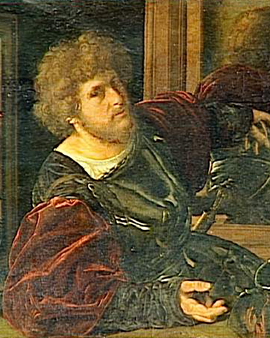His student Paolo Pino once lamented and regretted that Giovanni Girolamo Savoldo had been treated stepmotherly and unfairly by fate. His teacher had never received the respect and attention from his contemporaries that he and his work actually deserved. This has long since changed. For example, Andrea Bayer, deputy director for collections and administration at the Metropolitan Museum in New York, called Savoldo's work "Matthew and the Angel" one of the most moving night scenes in Italian Renaissance painting.
Giovanni Girolamo Savoldo has also gone down in art history as Girolamo da Brescia. For as little as his exact date of birth is known - he was born sometime around 1480 - we do know that the Italian painter came from Brescia. In fact, the artist referred to himself on some signed works as "de Brisia" or also "Brixciensis", which points to an origin from the second largest city in Lombardy. How his life journey continued from there lies in the dark. However, there is much to suggest that he learned his craft from various painters and traveled throughout northern Italy to do so. It is documented, for example, that he took lessons from Alessandro Araldi in Parma. But at that time the young Giovanni was probably not yet quite clear about his vocation. In any case, he also enrolled in the "Association of Physicians and Pharmacists" in Florence. Fortunately for the art world, however, he decided to pursue a career as a painter. And this decision quickly brought him artistic and financial success. It is documented that he was commissioned and paid by the court of Alfonso I d'Este for several works. With this important reference he laid the foundation for further commissions. For example, he was called to Treviso to finish a painting begun by the Venetian painter Fra Marco Pensaben for the main altar of the Dominican church of San Nicolò. He was also allowed to work for the patrons Francesco Giglio and Andrea Odoni. And the Venetian patrician Pietro di Gianruggero Contarini held Giovanni Girolamo Savoldo in such high esteem that he stipulated in his will that Giovanni should decorate the chapel in the church of Santi Apostoli - which no longer exists - with four works. The theme: the "Flight into Egypt", according to the only narrative of Jesus' childhood handed down in the Gospel of Matthew.
From Savoldo exist some biblical scenes, images of Madonnas and saints. Famous is his "Adoration of the Shepherds", of which there are two versions. But among the most famous works of the artist are undoubtedly the portrait "Young Man with Flute" and the "Portrait of a Man in Armor". The latter hangs today in the Louvre in Paris and still poses a mystery. It has not been proven whether it is a portrait of Gaston de Foix or a self-portrait by Savoldo. In any case, it impresses with a virtuoso, illusionistic play of shadows and light, which is further enhanced by the reflective effects of the armor.
×





.jpg)
.jpg)
.jpg)
.jpg)
.jpg)
.jpg)
.jpg)
.jpg)
.jpg)
.jpg)
.jpg)
.jpg)
_-_(MeisterDrucke-1460158).jpg)
_-_(MeisterDrucke-1460158).jpg)
.jpg)
.jpg)
_Painting_by_Filippo_Napoletano_(1587-162_-_(MeisterDrucke-1001598).jpg)
_Painting_by_Filippo_Napoletano_(1587-162_-_(MeisterDrucke-1001598).jpg)
_-_(MeisterDrucke-1400108).jpg)
_-_(MeisterDrucke-1400108).jpg)
.jpg)
.jpg)
.jpg)
.jpg)
.jpg)
.jpg)
.jpg)
.jpg)
.jpg)
.jpg)
_-_(MeisterDrucke-1415774).jpg)
_-_(MeisterDrucke-1415774).jpg)
.jpg)
.jpg)
.jpg)
.jpg)
.jpg)
.jpg)
.jpg)
.jpg)
_-_(MeisterDrucke-1403684).jpg)
_-_(MeisterDrucke-1403684).jpg)
.jpg)
.jpg)
_black_pencil_a_-_(MeisterDrucke-1462092).jpg)
_black_pencil_a_-_(MeisterDrucke-1462092).jpg)
.jpg)
.jpg)
.jpg)
.jpg)
.jpg)
.jpg)
.jpg)
.jpg)
.jpg)
.jpg)
.jpg)
.jpg)
.jpg)
.jpg)
_Peinture_de_Giov_-_(MeisterDrucke-1401333).jpg)
_Peinture_de_Giov_-_(MeisterDrucke-1401333).jpg)
.jpg)
.jpg)
.jpg)
.jpg)
.jpg)
.jpg)
.jpg)
.jpg)
.jpg)
.jpg)
_-_(MeisterDrucke-1416370).jpg)
_-_(MeisterDrucke-1416370).jpg)
.jpg)
.jpg)
.jpg)
.jpg)
.jpg)
.jpg)
.jpg)
.jpg)
_-_(MeisterDrucke-1403651).jpg)
_-_(MeisterDrucke-1403651).jpg)
.jpg)
.jpg)
.jpg)
.jpg)
_-_(MeisterDrucke-1409938).jpg)
_-_(MeisterDrucke-1409938).jpg)
.jpg)
.jpg)
.jpg)
.jpg)
_-_(MeisterDrucke-1402812).jpg)
_-_(MeisterDrucke-1402812).jpg)
_-_(MeisterDrucke-1415954).jpg)
_-_(MeisterDrucke-1415954).jpg)
.jpg)
.jpg)
.jpg)
.jpg)
_-_(MeisterDrucke-1630160).jpg)
_-_(MeisterDrucke-1630160).jpg)
_-_(MeisterDrucke-1415570).jpg)
_-_(MeisterDrucke-1415570).jpg)
.jpg)
.jpg)
_-_(MeisterDrucke-1404830).jpg)
_-_(MeisterDrucke-1404830).jpg)
.jpg)
.jpg)
_-_(MeisterDrucke-1630112).jpg)
_-_(MeisterDrucke-1630112).jpg)






